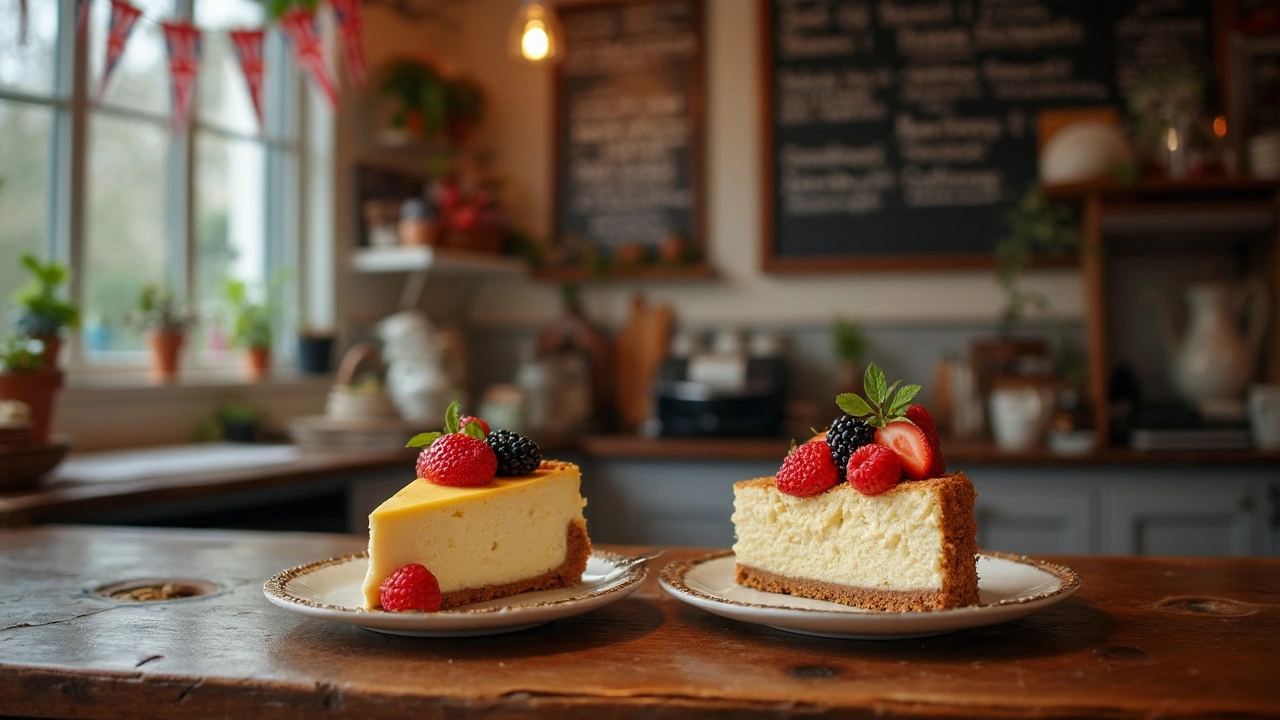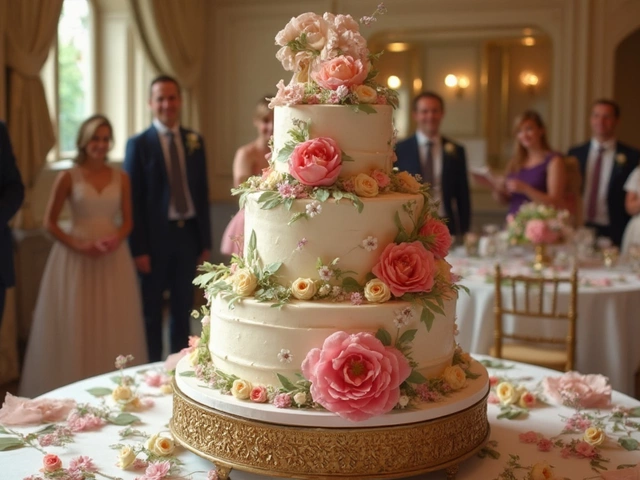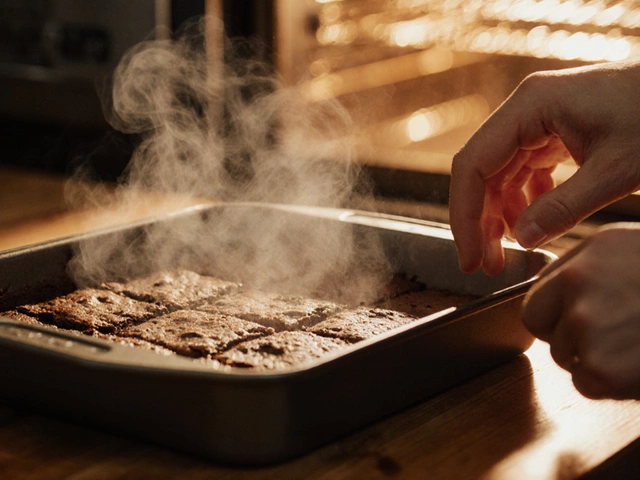Ever sliced into a cheesecake and found yourself wondering if it’s a New York style or Philadelphia style? Turns out, there’s way more going on than just the name. These two cheesecakes may look alike, but their stories and what goes inside them are pretty different.
If you’re tired of asking, “What makes this cheesecake New York and not Philadelphia?”—you're in the right place. Once you know where each one started and what goes into the batter, you'll spot (or taste) the difference right away. Plus, this can make or break your next batch if you're baking at home or picking out the perfect cake for a special occasion.
Let’s clear up the confusion and break down the exact things that set New York cheesecake and Philadelphia cheesecake apart. You’ll also get a few practical tips, so if you ever try baking both, you won’t just know the difference—you’ll taste it with every bite.
- Origins and History
- Key Ingredients
- Texture and Flavor
- Baking Methods and Tips
- Choosing the Right Cheesecake for You
Origins and History
If you want to understand New York cheesecake and Philadelphia cheesecake, you’ve got to go back to where each one started. Their histories might seem a little tangled, but there’s some clear stuff that separates these classics.
New York cheesecake really took off in the early 1900s in—you guessed it—New York City. It’s claimed that Arnold Reuben, the same guy behind the famous Reuben sandwich, was one of the first to serve this rich, creamy dessert in his Manhattan restaurant. The key? He used a crazy amount of cream cheese (and some cream), making the texture dense and smooth. Before this, folks across the U.S. made lighter cheesecakes with cottage cheese—nothing like what you'll find in New York today.
Philadelphia cheesecake isn’t actually tied to Philadelphia, Pennsylvania. The name comes from Philadelphia Cream Cheese, a brand first made in New York state in 1872. Back then, "Philadelphia" was a word folks trusted to mean "premium quality" dairy. Philly cheesecakes became popular in the mid-20th century when quick, “no-bake” cheesecakes and other creamy desserts started showing up in home kitchens.
Here’s a quick side-by-side:
| Style | First Famous | Main Claim to Fame |
|---|---|---|
| New York Cheesecake | Early 1900s, Manhattan | Super dense, lots of cream cheese and eggs |
| Philadelphia Cheesecake | Brand launched 1872; cake popular in 1950s | No-bake version takes off, lighter and smoother |
If you’re hunting for the OG bakery dessert with that deep, rich flavor, New York is your answer. If you want something you can whip up easier at home or bring to a summer potluck, Philadelphia cheesecake might be the way to go. These origin stories set the stage for all the differences in taste, texture, and how you make each style.
Key Ingredients
If you’ve ever checked out a New York cheesecake recipe, you’ll notice one thing right away: it’s richer. Heavy cream or sour cream is usually mixed right into the batter, and it almost always leans on a lot of cream cheese—most recipes call for several packs. Eggs are a big player, and some bakers even pop in an extra yolk for that dense texture. Add a sturdy graham cracker crust, and you’ve got the backbone of what people expect from this style.
Here’s a quick look at the basics for a classic New York cheesecake:
- Cream cheese (lots of it, often at least 2 pounds for a standard cake)
- Heavy cream or sour cream (amps up the creamy factor)
- Eggs (plus an extra yolk for that rich feel)
- Sugar (nothing fancy—regular granulated does the trick)
- Graham cracker crust (sometimes, you’ll see a sponge cake base, but that’s rare)
The Philadelphia cheesecake style is more straightforward and usually lighter. It’s got fewer ingredients you actually notice in the flavor, making it less dense and more about the smooth, almost mousse-like consistency. Philadelphia cheesecake recipes tend to skip the heavy cream and rely on just cream cheese, eggs, and sugar. The result? A cake that's fluffier and not quite as in-your-face rich as the New York version.
Check out what goes into a typical Philadelphia cheesecake:
- Cream cheese (but less than New York style)
- Eggs
- Sugar
- Optional splash of vanilla extract
Worried about calorie count or fat content? Here’s a real-world side-by-side. A slice of New York cheesecake can run around 450-500 calories because of all that extra cream—while classic Philadelphia cheesecake hovers closer to 300-350 calories per slice.
| Ingredient | New York Cheesecake | Philadelphia Cheesecake |
|---|---|---|
| Cream cheese | High amount | Moderate amount |
| Heavy cream/sour cream | Yes | No |
| Eggs | Multiple, plus yolk | Few |
| Texture helper | Extra yolk or cornstarch | Sometimes flour |
So if you’re at the store or planning your next bake, just remember: heavy cream means New York, simplicity means Philadelphia. Picking your ingredients with this in mind will nail the cheesecake style you’re going for.
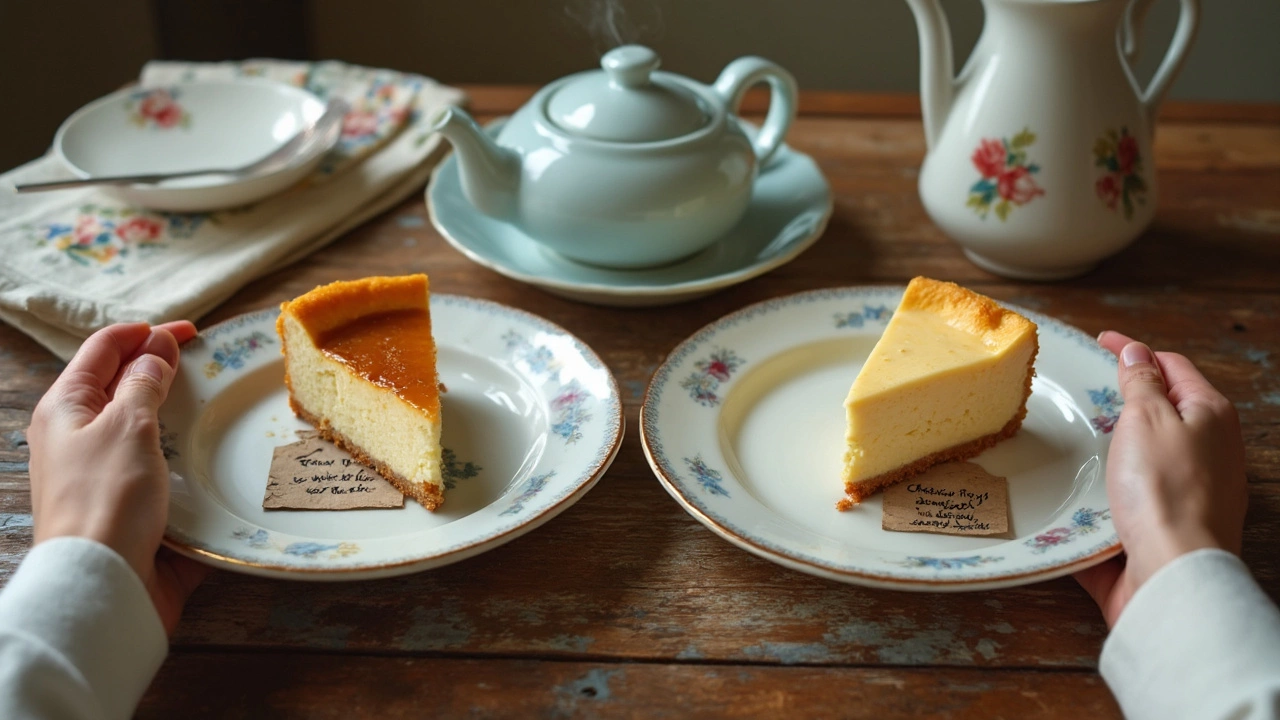
Texture and Flavor
Bite into a New York cheesecake and you’re in for a thick, dense, almost creamy wall of dessert. It’s firm enough to hold its shape but smooth and rich from start to finish. This comes from the heavy use of cream cheese—think two pounds or more for a standard recipe—plus a splash of heavy cream or sour cream, and sometimes even extra egg yolks. When you chill it overnight, the texture gets even more intense and luscious.
Philadelphia cheesecake goes for something a bit lighter. It's still creamy, but it’s softer and airier, like a cross between mousse and custard. It skips the heavy cream and uses slightly less cream cheese, so you won't get that same dense bite. It also tends to be sweeter and better at soaking up fruit toppings or syrups because it’s not as heavy-duty as the New York kind.
| Type | Texture | Flavor Notes |
|---|---|---|
| New York Cheesecake | Dense, firm, rich | Tangy, slightly savory, creamy |
| Philadelphia Cheesecake | Lighter, airy, smooth | Sweeter, milder, subtle vanilla |
If you’re into that restaurant-style, stick-to-the-fork richness, New York cheesecake is your best bet. But if you want a dessert that feels lighter or even a little fluffy, Philadelphia cheesecake is where it’s at.
- Tip: Room temperature ingredients make for an even creamier texture in both types.
- Tip: Want a stronger tang? Add a small spoonful of sour cream to your batter—especially for New York cheesecake.
Texture and flavor are the main reasons people swear by their favorite style, and once you try both, you’ll get why those differences matter so much.
Baking Methods and Tips
The way you bake a New York cheesecake isn’t the same as the approach for a Philadelphia cheesecake. In New York, the recipe almost always calls for baking. You’ll see a water bath (called a "bain-marie" if you want to sound fancy), because it keeps the thick, rich filling from cracking while making it creamy. Don't skip lining your springform pan with parchment or foil; it saves you from scrubbing and also prevents leaks.
For a classic New York version, here’s how people usually do it:
- Preheat the oven to a lower temp—most folks go around 325°F (160°C).
- Wrap your pan in a double layer of foil to keep water out.
- Fill the pan with the cheesecake mixture, tap out air bubbles, and set the pan into a larger roasting tray filled with about an inch of hot water.
- Bake until the center is just slightly jiggly—don’t over-bake or you’ll lose the famous creamy vibe.
- Cool the cake in the oven with the door cracked open for about an hour; this keeps it from sinking or cracking as it settles.
Philadelphia cheesecake, though, is often served no-bake. Many home cooks just whip the cream cheese, sugar, and sometimes whipped cream or condensed milk, then pour the filling into a graham cracker crust. Chill it in the fridge for at least 4 hours before slicing. Quick, simple, and you don’t even need to turn on the oven—perfect for summer parties or if your kitchen gets too hot.
If you’re caught between the two, here’s something cool: a lot of bakeries and home bakers experiment and tweak both styles. And to settle arguments, here’s a super quick breakdown comparison:
| Feature | New York Cheesecake | Philadelphia Cheesecake |
|---|---|---|
| Baking Required? | Yes | Usually No |
| Main Cream Cheese Brand | Any (often local brands) | Often Philadelphia brand |
| Texture | Dense & Creamy | Light & Fluffy |
| Water Bath | Yes | No |
A smart tip for any cheesecake: run a thin knife or spatula around the edge of the cake as soon as it comes out of the oven (or after it sets in the fridge for no-bake). This keeps it from sticking and helps avoid cracks. Also, always use room-temperature ingredients—this makes for smoother mixing and prevents lumps in your cake. If you ever mess up on the crust, don’t worry; a crumbled cookie base always fixes things, and people rarely complain if there’s extra crunch.
Whether you're a loyal New York cheesecake fan or you swear by Philadelphia cheesecake simplicity, these baking tricks will make your next dessert a winner.
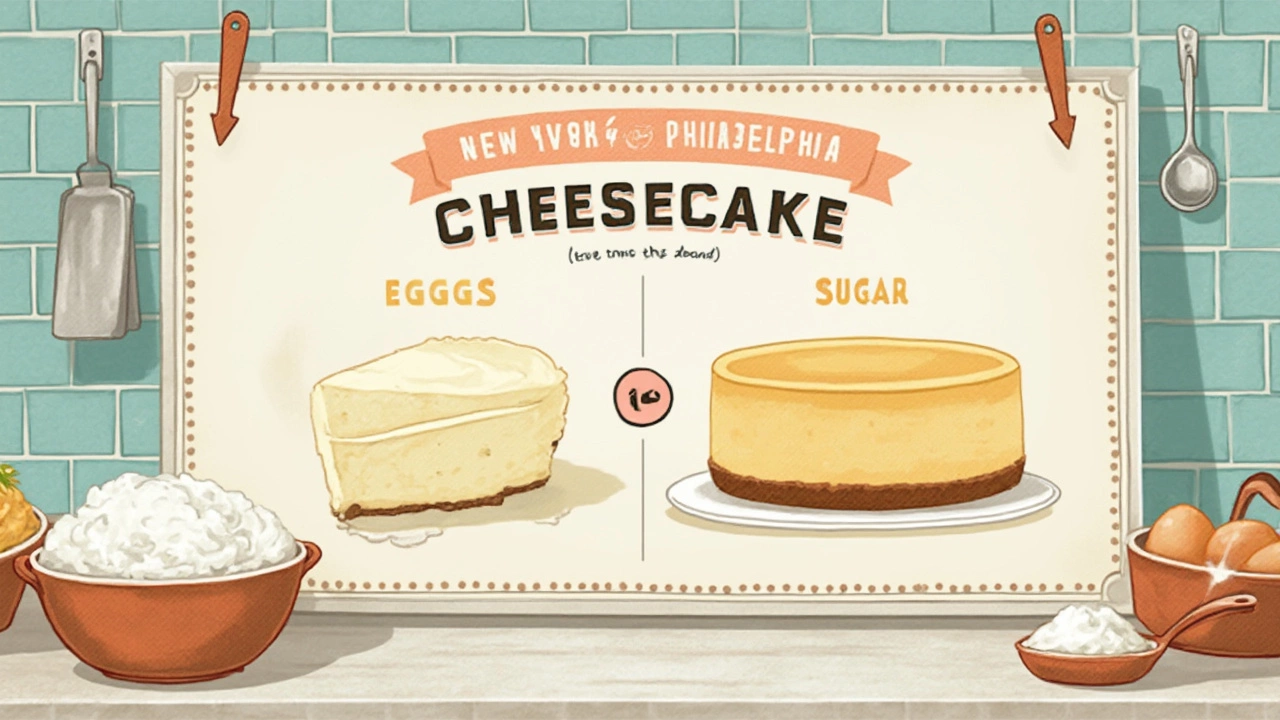
Choosing the Right Cheesecake for You
Picking between New York cheesecake and Philadelphia cheesecake isn’t just about where you live—it’s about what you’re in the mood for. These cheesecakes might look similar on the outside, but they hit totally different notes once you dig in.
If you love a super-dense, almost creamy-firm cake that makes you feel like you’re getting a big, rich dessert with every bite, go for New York cheesecake. Thanks to a hefty mix of cream cheese (sometimes extra egg yolks, a bit of flour, and heavy cream or sour cream), it’s that thick slice you probably picture from every diner scene in a movie. It’s also the kind that holds up toppings like fresh strawberries or chocolate sauce without getting soggy.
If you want something lighter, smoother, and a bit creamier—in a way that feels almost airy, without losing that classic cheesecake tang—Philadelphia cheesecake should be your pick. The Philadelphia style tends to skip the heavy cream and flour, sticking mostly with just cream cheese, sugar, and eggs, which gives a silkier texture and a clean, cheesy flavor.
Still don’t know which to make or buy? Here’s a quick breakdown:
- New York cheesecake is rich, heavy, and dense. Best for people who like their dessert to be filling and decadent.
- Philadelphia cheesecake is lighter, more delicate, and often a bit sweeter. Great if you want a dessert that feels less heavy or if you’re planning to eat a big meal beforehand.
Some fun data? According to a 2024 bakery survey of 2,000 Americans, 55% say they think of the classic New York style first when imagining cheesecake, while 30% pick the lighter Philadelphia version. The rest are split on regional flavors or specialty bakes.
| Type | Texture | Main Flavor Notes | Best Occasion |
|---|---|---|---|
| New York | Dense, rich | Tangy, creamy, slightly savory | Celebrations, winter desserts |
| Philadelphia | Smooth, creamy, light | Mild, slightly sweet, clean cheese | Summer parties, lighter meals |
When in doubt, think about your crowd and how heavy a dessert you want to serve. Still can't decide? Honestly, cheesecake freezes surprisingly well—make both, and stash some slices for whenever the craving hits.

